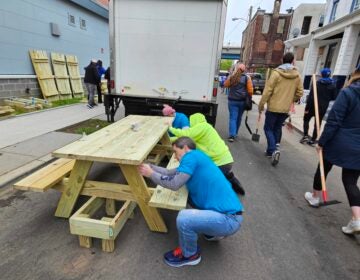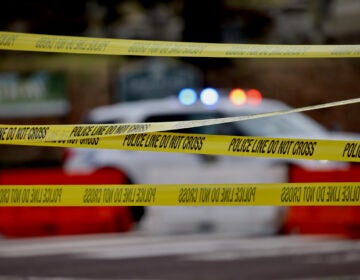Search continues for special victims co-location facility
A deal that would have put a co-location facility for police Special Victims Unit detectives and child victim advocates in East Falls died at the hands of a crowd of angry neighbors, but the will to create one somewhere in Philadelphia is very much alive, city officials say.
Some in East Falls objected — loudly — to the plan that would have brought together the SVU, the Philadelphia Children’s Alliance and Department of Human Services workers to Scotts Lane, just across from the McDevitt Recreation Center.
But city officials say Philadelphia will get a co-location facility, and suggested the attention the East Falls debacle garnered could eventually aid in the search for the right location.
“The facility will happen,” said Everett Gillison, the deputy mayor for Public Safety spearheading the effort for the Nutter administration. “And those that objected will end up asking themselves what was the big deal.”
Improving investigation and case collaboration
In reality, the push to create the multi-agency facility isn’t just a good idea or a law-enforcement trend — though more cities are creating colocation centers for sexual assault — it’s a must-do for the DHS.
A 2007 report of the Philadelphia Child Welfare Review Panel established in the wake of the Danieal Kelly case recommended the creation of a colocation site for improving DHS investigation and case collaboration. That report directed DHS to have a facility by Dec. 31, 2008, and it’s been referenced as an unmet goal in each update by the Community Oversight Board charged with making sure reforms are enacted.
The oversight board meets again in October, and DHS Commissioner Anne Marie Ambrose said she’s hoping to be able to bring them some positive news by then.
“Conceptually, everybody knows that this is the best thing to do for the city, but site issues are always really sticky,” Ambrose said. Over the years, potential sites at 9th Street and Sedgley Avenue, at the Germantown Army Reserve Center, and at the PCA’s current location, were considered but rejected for various reasons.
Gillison, who took the heat from angry East Falls residents at a public meeting on the Scotts Lane proposal in June, was adamant that a suitable site would be found and said its creation could be a legacy project for the Nutter administration that could have positive effects for decades.
“The mayor has made this a priority, knowing the history that this had been out there as something that everybody wanted to have happen,” Gillison said. “But it’s because of what I learned about how it would really impact victims that I threw my weight behind it.”
The concept
The concept behind a colocation facility is fairly simple: By putting the police who investigate sexual assaults in the same physical place as the human services workers and child advocates who handle abuse cases, the number of interviews the child has to give is reduced, lessening victim trauma.
The link between DHS, where most child sexual assault casework originates, and the police who investigate is the PCA, whose specially-trained investigators interview children in a suite of offices at 15th and Chestnut.
There, in a series of child-friendly and age-appropriate rooms, victims can meet with investigators while police or DHS workers observe via closed-circuit video or two-way mirrors. Right now, PCA handles about 130 allegations of sexual assault against children each month and the interview protocols they’ve developed since their founding in 1990 are used as a model in other cities.
It’s not a bad location, said Christine Kirchner, PCA’s executive director, but it’s less than ideal for coordinating the various investigators and case workers involved. The SVU operates out of a state-of-the-art facility at the Temple Episcopal Hospital campus at Front and Lehigh, and DHS workers who handle child sexual abuse cases are at 1515 Arch St.
Because less than 15 percent of child sexual assault reports have accompanying medical evidence, the victim’s statement is often key to case investigation and prosecution, Kirchner said.
“We’re here as neutral agents, to gather relevant, truthful information in a non-leading, developmentally appropriate way,” Kirchner said.
A collaborative effort
In a co-location facility, police detectives would be down the hall, rather than across town, and could sit in observation rooms while PCA interviews are taking place. The singular goal is to reduce the number of times a child victim has to repeat their story, and limit the number of different people the child has to connect with during the investigative process.
An early example was the Children’s Assessment Center in Houston, founded in 1991 and now serving as a model for the theory and practice behind collaborative investigation of child sexual assaults. Similar co-location facilities now exist in Essex County, New Jersey, at the Wynona’s House Child Advocacy Center and in Lehigh County, Pennsylvania.
“In an urban environment, and with the volume we have, having everybody living together is great,” Kirchner said. “To really make this effective collaboratively, you really need to have everyone in one place.”
Next steps
Gillison expressed disgust with the way the East Falls situation fell apart — calling some neighbors’ concerns that the area was being made a dumping ground for social service agencies “one of the most ridiculous things I’ve heard.”
Despite what he said was some deliberate misinformation that was spread about the facility — including the false prospect of the site being used as a a jail, or as a probation check-in facility for Megan’s Law offenders — Gillison recognized the politics of the situation and said he didn’t blame Councilman Curtis Jones Jr., in the end, for backing off.
“I was equally taken aback [when the deal fell apart] but I respect the various roles we all have. It may be that there may be some place else in [Jones’] district that this will fit,” Gillison said.
But he was clear that the Nutter administration won’t stop pushing to get a co-location facility created. If nothing else, the East Falls process did result in a set of site plans and a more concrete vision for what the facility would look like, after more than a decade of talking about it.
“The design we came up with is a good design,” Gillison said. “Now I just need to go out and find three empty acres.”
—
Contact Amy Z. Quinn at azquinn@planphilly.com
WHYY is your source for fact-based, in-depth journalism and information. As a nonprofit organization, we rely on financial support from readers like you. Please give today.




